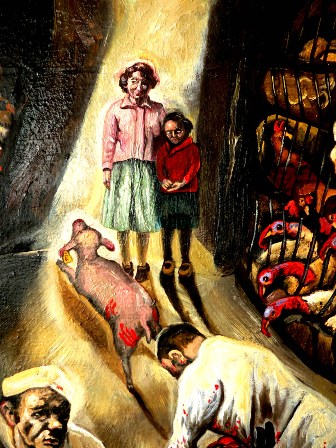A Painting Is Worth a Thousand Words
If you can, pick up a copy of this week’s New Yorker. There’s a review of Jonathan Safran Foer’s new book, Eating Animals, along with a photograph of a very powerful painting by artist Sue Coe—the same painting that Coe gave to PETA President Ingrid E. Newkirk. Ingrid is not ashamed to say that she burst into tears the first time she saw the painting, and she often talks about how powerfully it reminds people of the truth and horror of the slaughter business so casually supported by the majority of people.
 |
The painting is very Coe-esque—dark, haunting, and surreal. It looks like a nightmare put on canvas, and in fact, it is—a real-life nightmare. When Sue Coe was growing up, she lived next door to a hog factory farm and a block away from a slaughterhouse. In an essay she wrote for Ingrid’s book, One Can Make a Difference, Coe describes the events that inspired the painting:
One day, a small pig escaped the slaughterhouse, and she ran in and out of the traffic, desperate to get away. Men in white aprons, covered in blood, ran after her. Small groups of people congregated to watch, and they started to laugh and point. I asked my mother why this was so funny, and she said it was not funny, the pig was going to be caught and killed. . . .
When it came time to slaughter the pigs, which happened every six months or so, there would be a terrible noise at night. They’d whip the pigs to get them into the truck, and they would go down the road to the slaughterhouse. . . .
When I was about ten years old, I went with my friend to the door of the slaughterhouse and demanded to be showed around, as I wanted to know what was happening. The workers in the slaughterhouse … showed us everything that happens in the process of slaughter. The vision of the escaped pig couldn’t be ignored; she became louder and louder in my mind ….
This experience as a child sent me on my lifetime’s mission that was to be an artist, and to reveal what was being concealed. To get into places that have closed doors, and to give art the potential of changing the world, not just reflecting it.
Sometimes a picture is worth a thousand words. This one is. Even though we aren’t all gifted artists like Sue Coe or talented writers like Jonathan Safran Foer, there is still plenty that we can do to give animals a voice.
Written by Alisa Mullins

